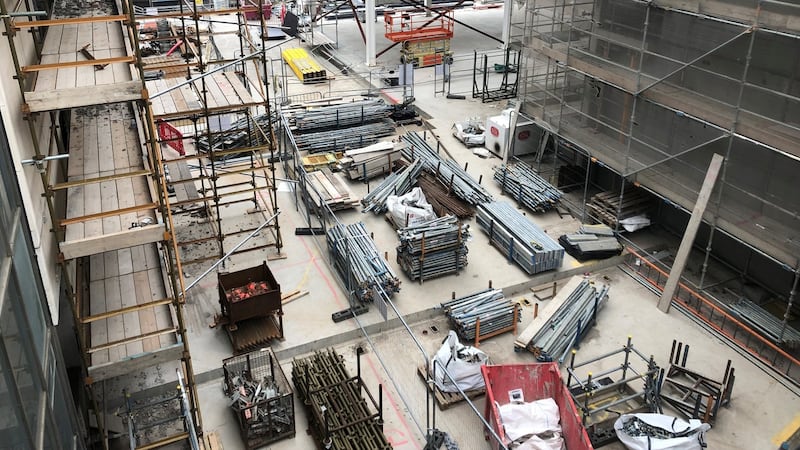On a freezing March morning, Ciaran Black stands on the southbound Luas bridge platform at Charlemont, pointing at a sprawling concrete building site below, ground zero for local hostility.
The cause of tensions is not the visible redevelopment of the former Irish Nationwide Building Society on Grand Parade. It is what lies beneath that is causing a widening fissure between community and planners.
Underneath the building site, preliminary foundation works have been carried out for the construction of a MetroLink interchange or terminus, even though planning permission has yet to be sought.
For residents, it is an utterly inappropriate location for an underground station potentially ferrying Dublin’s southside community to and from the city’s airport.

Those who live here, particularly around Dartmouth Square – an affluent Victorian rectangle of three-storey redbrick homes – are incensed at what might be coming.
“Most of it is bewilderment that the NTA [National Transport Authority] is not being challenged on this. Is this area really the best place for a city-centre terminus for the next 25 to 30 years? Of course it isn’t,” says Black.
With time running out, Black is to the forefront of efforts to force an 11th-hour rethink. Residents have the backing of councillors who have sought a study on potential alternatives sites, with St Stephen’s Green the most prominent option.
The NTA has said it will seek planning permission this year for the MetroLink to run from Swords to Charlemont and a business case is due soon. Last November, the authority said any further southside rail connection would not be built until after 2042.
Black and his family live on Dartmouth Road, right beside the Luas green line. If the terminus goes ahead, they could be staring at building hoardings outside their front gate for years.
But casting off suggestions of "nimbyism", he cites several reasons residents believe the area is unsuitable for such a rail hub. These are outlined in detailed literature and a website – misplacedterminus.ie – and include concerns over traffic, an absence of transport links and perceived design flaws.
Although it would be possible to get the Luas to the terminus, residents argue this will not suit everyone and many, particularly those bound for the airport with heavy luggage, will opt to be dropped off and collected along the small, relatively inaccessible roads around Dartmouth.
“It’s [about] the ability of this community to be able to absorb the amount of people. Even a small amount of people would be difficult,” says Black. “Effectively, the whole of the south side, if they want to drop off and pick up, they are going to come here.”
Congestion
Local architect and town planner James Pike also believes a terminus at Charlemont stands to cause congestion. "The main drop-off point would be along Dartmouth Road which does not have the width. And the canal [to the front] is not an option because it's extremely busy anyway."
But for the NTA there are several reasons why Charlemont represents a good option. A spokesman points to proximity of the interchange between the Luas and the MetroLink, much closer than would be the case at St Stephen’s Green. He says the authority believes future extension options are attractive, “whether to connect on to the green line or to provide a metro to the southwest of the city”.
Some residents consider the initial work at the site to have been executed without the level of transparency or due process they would like. Many believe it pre-empts the statutory planning process, thus “locking in” the route for the line.
"It's not only that they drilled down physically, but they drilled down psychologically as well," says Edward Kelly, a retired businessman who has lived on Cambridge Terrace for 25 years, and believes the move will commit planners to the site given the money spent.
All signs point that way, but residents still hold out hope for an alternative.
"Along with many others on the southside, we have argued that a St Stephen's Green terminus provides the greatest range of future possible southern route extensions," residents said in a letter to Minister for Transport Eamon Ryan.
Independent councillor Mannix Flynn, one of many on Dublin City Council supporting the residents, believes that of most concern is about the commencement of works at Charlemont. “These are public works. You can’t just turn around and say, okay here’s an opportunity,” he says. “Here is the State undermining the process itself.”
For some, it is not just the specifics of the planning at issue, but the nature of how officials have gone about it.
Surrounded by design sketches and papers in her Dartmouth Square kitchen, architect Caitriona Shaffrey, who takes a particular interest in the study of urbanism, gets visibly frustrated when talking about the terminus.
“We all want a metro but a metro that works,” she says. But the approach of transport officials, to her mind, is “we have to have a metro. The fact that it doesn’t work doesn’t seem to bother them.
“They are not listening . . . It’s such an expensive project you have to get it right but we have a history in this country of just pushing things through,” she says.
Consultation
Lorraine Power, a researcher in social policy, says accusations of "nimbyism" had initially made her reticent to speak out but the process began to feel undemocratic.
“They will say they had consultation but it’s just like, talk to the hand,” says Power. She, her husband and four children are among a number of young families to have recently moved to the square. “I don’t want to say it will be terrible because we don’t know,” she says. “But it seems like they are going to spend a lot of money to get to a place that won’t have all the different types of transport to be a hub. We are not set up for that like the way St Stephen’s Green is.”
Edward Kelly, who has lived for a quarter of a century in the area, notes that Dartmouth Square was not always the wealthy, sought-after address it is now. In the 1970s it was part of “flatland”; homes were often run down and neglected.
Kelly shows a picture of the square from 1890 with people picking through a refuse dump. Later, the park would be used as a hockey pitch and in 2006, its then owner Noel O’Gara briefly transformed it into a car park.
“It is the case that we live here and enjoy the benefits but we won’t all be living here forever,” Kelly says. “The area will pass on and there’s something wonderful about it that is worth passing on. You want to be able to feel you asked the right questions.”




















